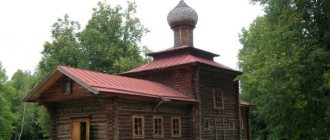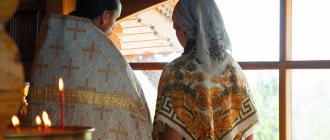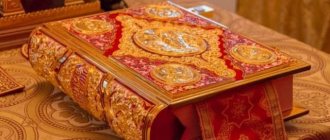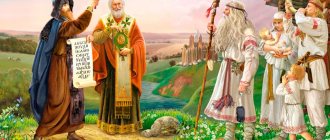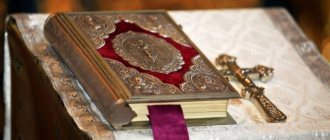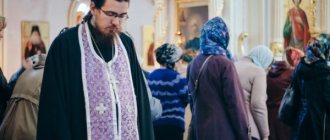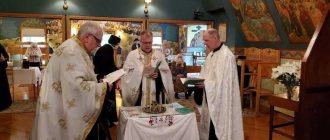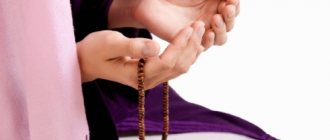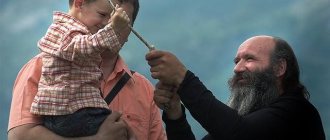Is it worth sending your child to an Orthodox school?
An Orthodox school for children appears today in almost every church, because the Christian tradition is returning to our country.
Passions, sins and problems are also found in Sunday schools, but the wonderful thing is that there are monks there interpreting the Holy Scriptures and reading prayers. The seed of a virtuous attitude to life grows in the hearts of young students, which they will spread beyond the boundaries of this educational institution.
Orthodox gymnasium in the village. Zaplavnoye, Volgograd region
Typically, an Orthodox classical gymnasium begins training in the first days of September. If parents decide to send their child to such a school, preparatory measures are necessary: the applicant must be baptized and familiar with the traditional rules of visiting temples, as well as church holidays.
About Orthodox upbringing of children:
- How to raise and instill in a child faith in God
- Sunday schools for children
- What books should children read about Orthodoxy?
Important!
In order for religious education to bear significant fruits, the correct attitude of parents is necessary, since students cannot realize all the benefits at a young age. The mother and father must live unfeignedly, according to the Scriptures, because the priests talk about the same thing in their lessons. The child must see the consistency of what is said at school and with his family. If parents behave recklessly and blaspheme, an Orthodox school can cause harm. For families of religious people, religious schools are a real necessity.
Are the children not the same anymore?
Photo by Vladimir Eshtokin
Many people believe that children deteriorate year after year, which used to be “oh-ho-ho,” but now “alas.” I strongly disagree with this! In fact, everything is much more complicated; there are different, sometimes diametrically opposed processes. I can say that in recent years our students for the most part have become much more conscious than before. Nowadays deviant behavior is very isolated cases, but in the past this happened much more often. Now children understand very well why we need to study, why we need to pray, why we do this, why we do this. Their faith, according to my observations, becomes more meaningful. Although there are also negative trends - children read less, spend less energy even on what they are interested in. They become lazier, and the reasons for this are outside of school. The reasons are in the “spirit of this age”, with its massive desire for comfort, fear of responsibility, fear of taking initiative...
The difference between an Orthodox gymnasium and a regular school
During the lessons, children get acquainted with the basics of Christianity, history and culture of religion. Teachers, who are hieromonks, holy fathers and their wives, note the positive influence of Orthodox schools on students. Such religious institutions offer engaging and understandable teaching that does not cause boredom. The program was created taking into account the age category and develops various nuances of pedagogical work.
- In Orthodox gymnasiums there is a conventional division into classes. Primary schools educate children under four years of age; they are brought by their mothers. It often happens that a parent who is far from religion becomes a frequent visitor to this place.
- In the second class, children from 4 to 8 years old are taught, and in the third class, from 8 to 12, etc. The number depends on the teaching methodology, the abbots and the prescribed programs.
Orthodox gymnasium - Each individual Orthodox gymnasium has individual routines and schedules, which you should definitely familiarize yourself with. Classes for boys and girls, who must wear headscarves and long skirts, take place separately. There is no charge for training in Sunday institutions.
- Teaching methods for children under 4 years old involve the use of educational and interesting games. They draw, sing, and sculpt from plasticine with great pleasure. Each craft is created with a Christmas or Easter theme, and stories and stories are read from the Bible for children. Interesting riddles are rich in religious overtones, which allows the youngest students to absorb the spirit of the Church from early childhood.
- Each class hour begins and ends with prayer chants. Older children go with their parents and novices to a special service. Frequent attendance at Sunday gymnasiums gives students a feeling of closeness to church structures. Surrounded by righteous people, individual faith in the Lord strengthens.
- The second grades of Russian Orthodox gymnasiums are being prepared for entry into regular schools. Classes last three hours, without parental supervision. Here students gain their first experience of independence and individual action. The basics of crafts, theater, etc. are added to the basic disciplines. Each activity is a kind of charity that brings great benefits to all those in need.
- In third grades, daily teaching time increases to 4 hours. Students master the church language and the Holy Gospel, and also practice painting icons and singing in the choir.
Tell me, father
One of the students constantly knocks on my office: “Father, can I talk to you?” Both kids and high school students come and talk about their problems, difficulties in relationships with parents and friends. Moreover, they know: I will never scold them. No matter what the child tells me, I will not raise my voice or start shaming him. If he is very wrong about something, I carefully, with leading questions, help him look at the situation differently. “And imagine yourself at this moment in your mother’s place, what would you think about?” “What if you try to ask for forgiveness? I remember from my childhood how difficult it is, but believe me: it helps a lot!”
Main trends in gymnasiums
The main goal of religious educational institutions is to spiritually enlighten the younger generation. The modern age offers the child colossal spaces, which more often turn out to be negative and lead to a sinful path. The Orthodox classical gymnasium sorts this huge flow of information, discards the bad, leaving the necessary, which is taught to children in an accessible form.
Orthodox school class
Lessons are built on the principle of dialogue, which is interesting for everyone. Each child has the right to express his opinion, which is carefully listened to by the church teacher. In these pleasant conversations, children receive answers to their questions, gain positive experiences of communicating with balanced people, and also learn to find better solutions. In dialogues, the student improves the quality of his speech and is taught to listen carefully to the speaker.
Religious material is presented in simple and understandable language; children have the right to draw their own conclusions. Often hieromonks and priests use audio and video materials that facilitate perception. In Orthodox gymnasiums, intellectual tournaments are held, where children strengthen their own knowledge of a religious subject.
On a note! Sunday schools appeared in an effort to reclaim educational space from secular institutions. When sinful depravity spread in the 90s, believers organized specific “islands of salvation.”
Over the course of two decades, religious gymnasiums have accumulated experience and come a long way. Managers discovered errors and corrected them in a timely manner.
Orthodoxy and children:
- Orthodox films for children
- Orthodox cartoons for children
- Conversations with children about the Orthodox cross
Don't be a herd
From a trip to Kolomna. High school students regularly go on pilgrimage trips around Russia and even abroad. Photo from the gymnasium archive
We teach children, especially high school students, that they will have to live in a very unstable world, in a world where a variety of shocks are possible - economic, political, man-made. In such upheavals, it is very difficult to keep a clear head, not to succumb to the “herd mentality”, not to do some stupid things that can distort life. How can you resist? Only with a clear hierarchy of values, only with solid support. And this support is the Church.
Prepared by Vitaly Kaplan
Moscow Theological Academy
Founded in 1685 and originally called the Slavic-Greek-Latin Academy, the Moscow Theological Academy is the first higher school in Russia and one of the centers for the development of Orthodox education and ecclesiastical science in the Russian Orthodox Church.
The Academy includes 6 structural divisions: bachelor's, master's, postgraduate, doctoral, regency and icon painting schools.
The Academy is an educational, scientific, theological and research center that trains clergy, teachers of church educational institutions, church scientists and other specialists of the highest scientific qualifications in the field of Orthodox theology.
St. Petersburg Theological Academy. Magazine "Nevsky Theologian"
(FLV file. Duration 4 min. Size 26.6 Mb)
St. Petersburg Theological Academy is one of the higher educational institutions of the Russian Orthodox Church, founded in St. Petersburg in 1721.
Currently, it is a complex of religious educational institutions, united by the code name St. Petersburg Theological Schools.
St. Petersburg Theological schools include:
- The Theological Academy is a scientific, theological, educational and research center that trains clergy, teachers of theological educational institutions, church scientists and other specialists of the highest scientific qualifications in the field of Orthodox theology in postgraduate and doctoral programs. The Academy has the following forms of education: full-time (stationary) and external (correspondence). The standard period for completing the program for full-time study is 2 years, for part-time study - 2 years. There are several departments - biblical, theological, church-practical and church-historical.
- A theological seminary is a higher theological educational institution that trains clergy, as well as clergy and church specialists. The seminary has the following forms of education: full-time (stationary) and external (correspondence). The standard period for completing the program is 4 years.
- The regency department is a secondary specialized educational institution that trains regents. The Regency Department does not offer external studies, evening or correspondence courses. Duration of training - 4 years. About 90 students study in the department.
- The icon painting department is a special spiritual educational institution of the Moscow Patriarchate that trains icon painters for the Russian Orthodox Church. Duration of training - 4 years.
- Faculty of Foreign Students - training of students both in individual programs, including in-depth study of the Russian language, and in general programs of the Academy, Seminary, as well as the Regency or Icon Painting Department. Currently, the Faculty has students from Bosnia and Herzegovina, Germany, Greece, China, Lithuania, Macedonia, the Netherlands, Poland, Serbia, Thailand, Finland, Montenegro, Sweden, Estonia and one student from Norway.

